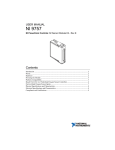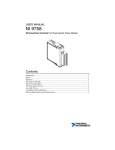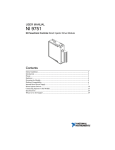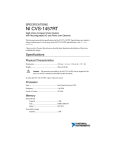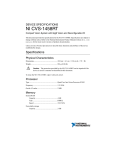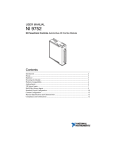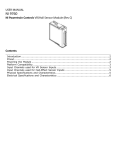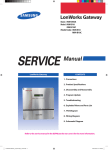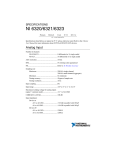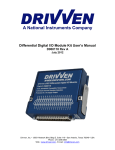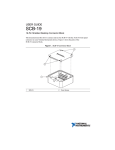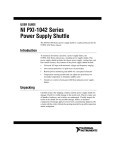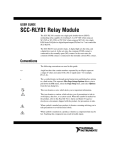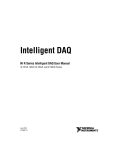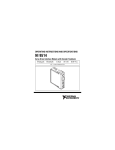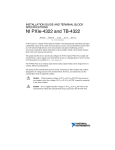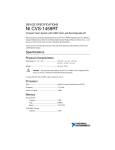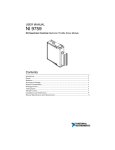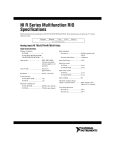Download NI 9753 User Manual - National Instruments
Transcript
USER MANUAL NI 9753 NI Powertrain Controls Differential Digital I/O Module Contents Introduction .............................................................................................................................. 2 Pinout........................................................................................................................................ 2 Hardware .................................................................................................................................. 3 Powering the Module................................................................................................................ 3 Platform Compatibility ............................................................................................................. 4 Inputs and Outputs.................................................................................................................... 5 Compliance and Certifications ................................................................................................. 5 Output Characteristics .............................................................................................................. 7 Input Characteristics ................................................................................................................. 7 Physical Specifications and Characteristics ............................................................................. 7 Introduction The National Instruments 9753 Differential Digital I/O Module includes a CompactRIO (cRIO) module with eight individually controlled inputs or outputs with 50 ns resolution. When the channels are configured as outputs, the channels can be controlled by a customized Boolean logic or by specialized fuel and spark VIs included with the NI 9753, in which case, an Engine Position Tracking (EPT) VI is also required.The NI 9753 fuel and spark VIs provide control similar to that of NI’s fuel and spark driver module kits. The NI 9753 outputs do not drive current sufficient for driving fuel injectors or ignition coils. The outputs can be used for commands to external custom driver circuits or smart actuators with built-in driver circuits. Multiple fuel and spark VIs can be wired together through OR logic gates to deliver multi-pulse engine-synchronous commands to a single output. When the channels are configured as inputs, the Boolean signals from these channels can be used as general purpose Boolean Trigger signals within the LabVIEW FPGA application. Each I/O channel uses an RS485/422 compatible differential transceiver with a voltage range of 0 V to 5 V. Features • 8-channel differential digital I/O with RS485/422 compatible transceivers • Individual channel direction selection • Protected 5 V, 1 A supply output • 50 ns input and output resolution Pinout Figure 1. NI 9753 Pin Assignments 2 | ni.com | NI 9753 User Manual Hardware The NI 9753 has eight channels of RS485/422 compatible differential digital inputs or outputs in a NI CompactRIO module form factor and provides a 5 V sensor power output and ground. NI recommends using the NI 9923 Connector Kit for connections to the NI 9753. The NI 9923 provides proper strain relief for NI 9753 connections. Visit ni.com/info and enter Info Code DIFFIO for more information on parts and accessories for the NI 9753. Powering the Module The NI 9753 requires power from two different sources, the CompactRIO backplane male high density D-SUB 15-pin (HD15) connector and the external DB-37 connector. The HD15 connector mates with the module’s female HD15 connector. It provides a regulated 5 V and ground to various digital logic functions within the NI 9753. It is active whenever the CompactRIO or R Series Expansion Chassis is properly powered. The NI 9753 should be powered at the HD15 connector by plugging it into a CompactRIO or R Series Expansion Chassis. The module’s HD15 connector should not be connected to any other device. The other power connection is at the external DB-37 connector labeled BATT (19) and GND (18). Typical power sources will be from automotive 12 V or 24 V battery systems. The NI 9753 can accept power from a range of 6 V to 32 V. The maximum power to the NI 9753 is limited to 5 W. When the 5 V supply output is not being utilized, the NI 9753 requires up to 2 W from the external supply, depending on the number of channels operated as outputs and on their switching frequency. The external 5 V supply output can be used for the remainder of the 5 W power limit. If the external 5 V supply output is shorted or overloaded, then the voltage output level will be reduced in order to limit the total power to 5 W. This will cause the I/O transceivers to shutdown. The NI 9753 requires both external power and power from the CompactRIO backplane. The NI 9753 directs the high current path through the BATT and GND terminals on the front of the module and not through the HD15 backplane connector. Note The NI 9753 will not be recognized by software without both power supplies active. Note The external battery supply is not required in order for the NI 9753 to be recognized by LabVIEW FPGA software. The RS485/422 channel transceivers will not be active without the external battery supply. NI 9753 User Manual | © National Instruments | 3 Platform Compatibility NI Powertrain Control modules require a hardware support system to function. You cannot use the modules independently or interfaced with third-party devices at the backplane HD15 connector. NI Powertrain Control modules are compatible with the following National Instruments platforms: • CompactRIO, which consists of a CompactRIO controller, chassis, or integrated controller/chassis. • NI PXI, which consists of any NI PXI chassis, NI PXI RT controller, and NI PXI-78xxR R Series FPGA card. The NI Powertrain Control modules insert into an NI R Series expansion chassis. Connect an NI R Series expansion chassis to the NI PXI FPGA card using a SHC68-68-RDIO cable. NI Powertrain Control modules are not compatible with the National Instruments CompactDAQ chassis. Note You can use NI Powertrain Control modules with NI cRIO-911x, NI cRIO-907x, and NI R Series Expansion systems under the following conditions: • Leave one empty chassis slot between NI Powertrain Control modules and other NI modules. • Maintain an ambient system operating temperature of 0 °C to 45 °C. Typical specifications of National Instruments modules might not apply when used in a system with NI Powertrain Control modules. Note National Instruments guarantees warranted specifications for all National Instruments modules except thermocouple modules when used in a system with NI Powertrain Control modules. Note National Instruments recommends the NI 9214 for thermocouple measurements in CompactRIO systems using NI Powertrain Control modules. Note NI Powertrain Control modules do not support Scan Interface mode, auto-detection, or ID mode. Note 4 | ni.com | NI 9753 User Manual Inputs and Outputs Each differential I/O channel can be individually configured for input or output and meets or exceeds TIA/EIA RS-485 requirements. Channels with signaling rates up to 10 Mbps are configured for input or output via the provided LabVIEW FPGA VI. Overvoltage Protection The RS485 input/output pins of the NI 9753 can be shorted together, shorted to ground, or shorted to -7 V to +12 V without damaging the channels. The RS485 input/output pins may be subjected to ±50 V, 15 µs wide, 1% duty cycle pulses via a minimum of 100 Ω resistance without damage. A channel differential pin pair can withstand a differential input voltage of ±12V. Compliance and Certifications Safety This product meets the requirements of the following standards of safety for electrical equipment for measurement, control, and laboratory use: • IEC 61010-1, EN 61010-1 • UL 61010-1, CSA 61010-1 Electromagnetic Compatibility This product meets the requirements of the following EMC standards for electrical equipment for measurement, control, and laboratory use: • EN 61326-1 (IEC 61326-1): Class A emissions; Industrial immunity • EN 55011 (CISPR 11): Group 1, Class A emissions • AS/NZS CISPR 11: Group 1, Class A emissions • FCC 47 CFR Part 15B: Class A emissions • ICES-001: Class A emissions Caution When operating this product, use shielded cables and accessories. CE Compliance This product meets the essential requirements of applicable European Directives as follows: • 2006/95/EC; Low-Voltage Directive (safety) • 2004/108/EC; Electromagnetic Compatibility Directive (EMC) NI 9753 User Manual | © National Instruments | 5 Environmental Management NI is committed to designing and manufacturing products in an environmentally responsible manner. NI recognizes that eliminating certain hazardous substances from our products is beneficial to the environment and to NI customers. For additional environmental information, refer to the Minimize Our Environmental Impact web page at ni.com/environment. This page contains the environmental regulations and directives with which NI complies, as well as other environmental information not included in this document. Waste Electrical and Electronic Equipment (WEEE) At the end of the product life cycle, all products must be sent to a WEEE recycling center. For more information about WEEE recycling centers, National Instruments WEEE initiatives, and compliance with WEEE Directive 2002/96/EC on Waste and Electronic Equipment, visit ni.com/environment/ weee. EU Customers Battery Replacement and Disposal This device contains a long-life coin cell battery. If you need to replace it, use the Return Material Authorization (RMA) process or contact an authorized National Instruments service representative. For more information about compliance with the EU Battery Directive 2006/66/EC about Batteries and Accumulators and Waste Batteries and Accumulators, visit ni.com/ environment/batterydirective. Battery Directive Cd/Hg/Pb ⬉ᄤֵᙃѻક∵ᶧࠊㅵ⧚ࡲ⊩ ˄Ё RoHS˅ Ёᅶ᠋ National Instruments ヺড়Ё⬉ᄤֵᙃѻકЁ䰤ࠊՓ⫼ᶤѯ᳝ᆇ⠽䋼ᣛҸ (RoHS)DŽ݇Ѣ National Instruments Ё RoHS ড়㾘ᗻֵᙃˈ䇋ⱏᔩ ni.com/ environment/rohs_chinaDŽ (For information about China RoHS compliance, go to ni.com/environment/rohs_china.) 6 | ni.com | NI 9753 User Manual Output Characteristics Digital Output Logic Levels at 8 mA loads High .................................................................. 4.0 V to 5.0 V Low................................................................... 0.1 V to 0.4 V Input Characteristics Differential Input Logic Levels High .................................................................. (a - b) > 200 mV Low................................................................... (a - b) < -200 mV Physical Specifications and Characteristics Weight............................................................... 170 g Maximum Altitude ........................................... 2000 m Maximum Ambient Temperature ..................... 70 ºC Operating Humidity .......................................... 10% to 90% RH, noncondensing Pollution Degree ............................................... 2 Ingress Protection ............................................. IP40 For indoor use only. If you need to clean the module, wipe it with a dry towel. Safety Guidelines Do not operate the NI 9753 in a manner not specified in these operating instructions. Product misuse can result in a hazard. You can compromise the safety protection built into the product if the product is damaged in any way. If the product is damaged, return it to National Instruments for repair. Caution NI 9753 User Manual | © National Instruments | 7 Refer to the NI Trademarks and Logo Guidelines at ni.com/trademarks for more information on National Instruments trademarks. Other product and company names mentioned herein are trademarks or trade names of their respective companies. For patents covering National Instruments products/technology, refer to the appropriate location: Help»Patents in your software, the patents.txt file on your media, or the National Instruments Patents Notice at ni.com/patents. You can find information about end-user license agreements (EULAs) and third-party legal notices in the readme file for your NI product. Refer to the Export Compliance Information at ni.com/legal/export-compliance for the National Instruments global trade compliance policy and how to obtain relevant HTS codes, ECCNs, and other import/export data. © 2013 National Instruments. All rights reserved. 376102A-01 Jun13








